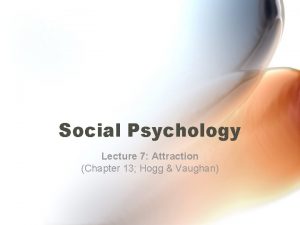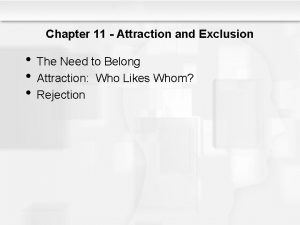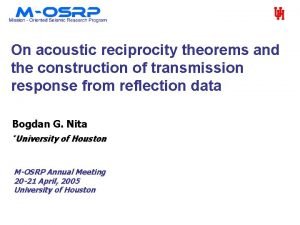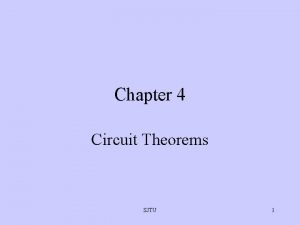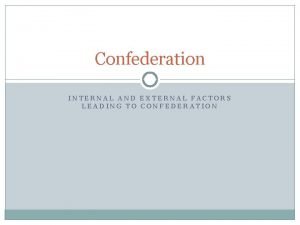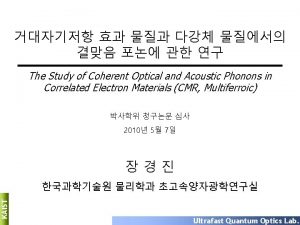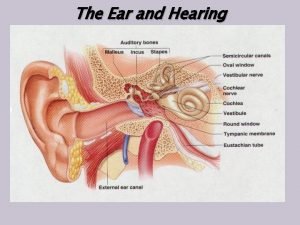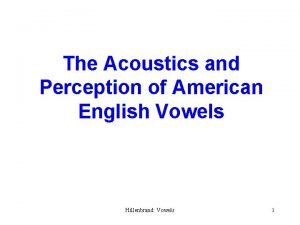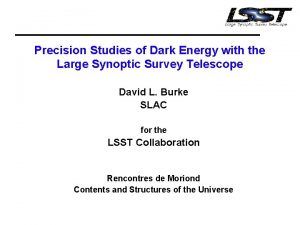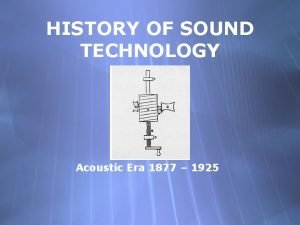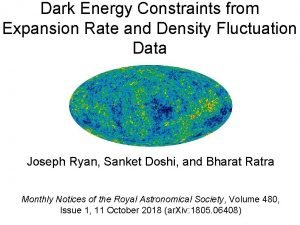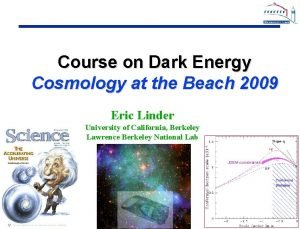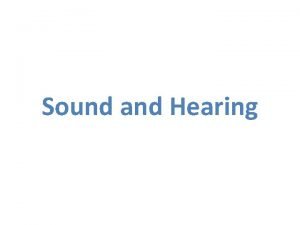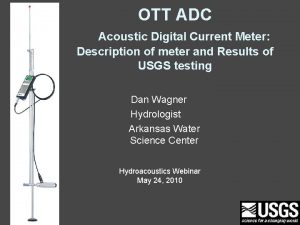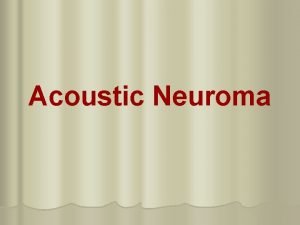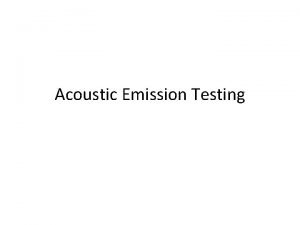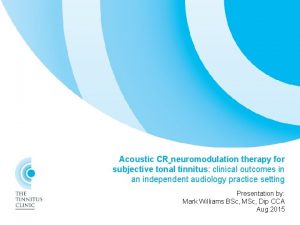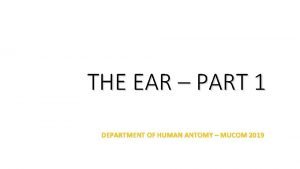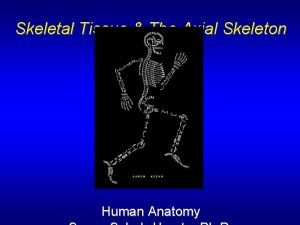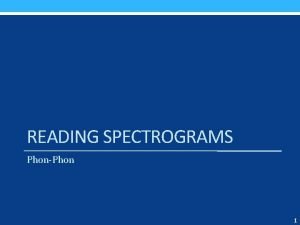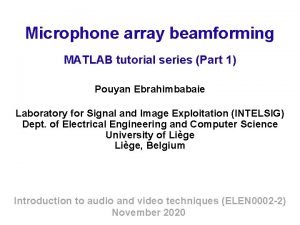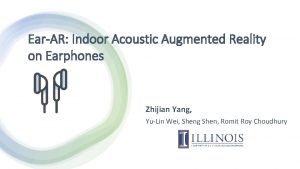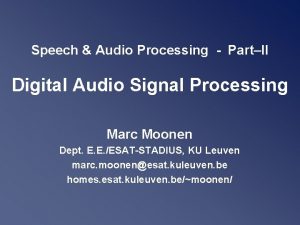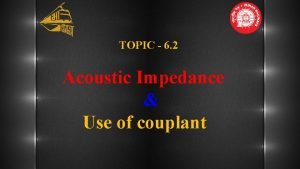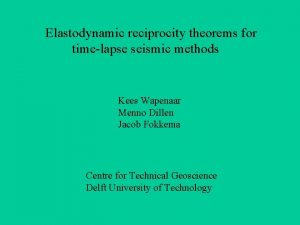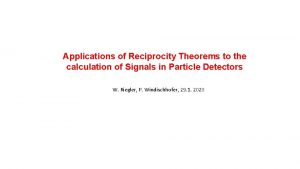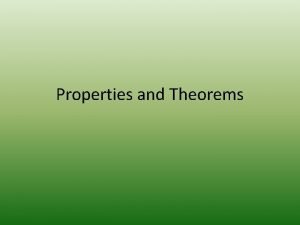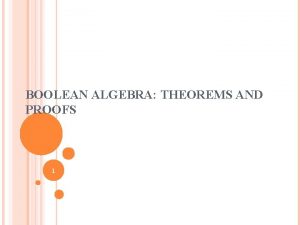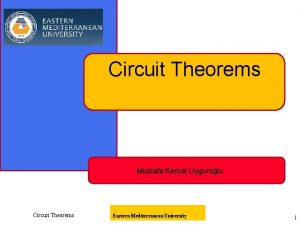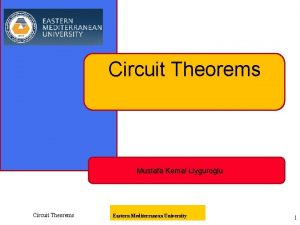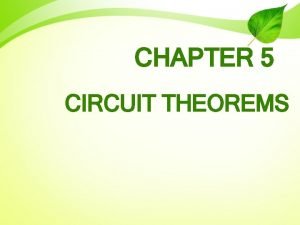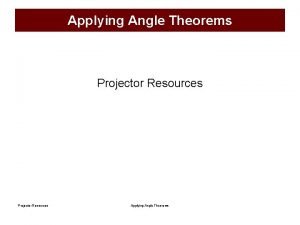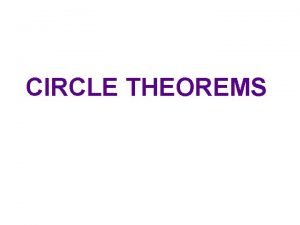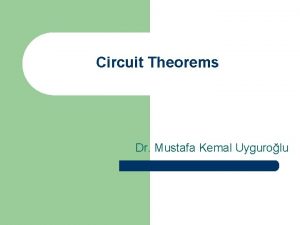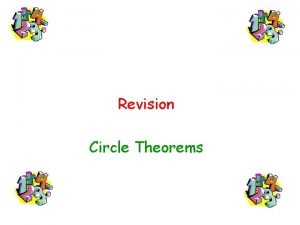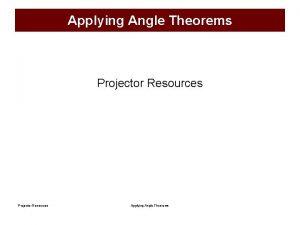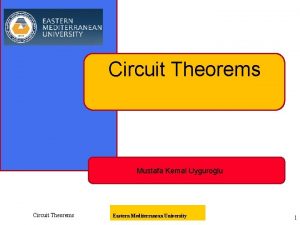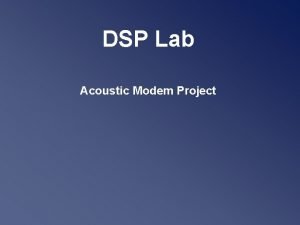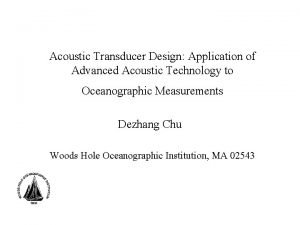On acoustic reciprocity theorems and the construction of












































- Slides: 44

On acoustic reciprocity theorems and the construction of transmission response from reflection data Bogdan G. Nita *University of Houston M-OSRP Annual Meeting 20 -21 April, 2005 University of Houston

Outline • • Motivation One-way wavefield decomposition Reciprocity theorems Reconstructing the phase from amplitude information • Minimum phase condition • Summary and Conclusions

Outline • • Motivation One-way wavefield decomposition Reciprocity theorems Reconstructing the phase from amplitude information • Minimum phase condition • Summary and Conclusions

Motivation • Virtual source – Shell • Seismic interferometry • Deep earth seismology • Model type independent imaging

Inverse scattering imaging • Inverse scattering imaging subseries method has shown tremendous value for 1 D and 2 D acoustic media (Shaw, Liu) • H. Zhang leads the efforts to identify the subseries for imaging in a 1 D elastic medium • Model type independent method

Internal multiple attenuation subseries = G 0 =D • The attenuation algorithm requires three reflection data sets to build up an internal multiple = Imaged Data

Leading order imaging sub-series Linear 2 nd Order 3 rd Order 4 th Order = G 0 + = V 1 + A subseries of the inverse series + + …

Data requirements for model type independent imaging Reflection data Transmission data

Methods for obtaining transmission data • Measure/record it (e. g. VSP) • Determine it from reflection data using reciprocity theorems Inverse scattering series constructs the transmission response order by order from reflection data •

Outline • • Motivation One-way wavefield decomposition Reciprocity theorems Reconstructing the phase from amplitude information • Minimum phase condition • Summary and Conclusions

Seismic experiment FS At any depth, the total wavefield has an up-going and a down-going component

Two way wavefield reciprocity FS • Acoustic response does not change if the source and receiver are interchanged

Two way wavefield reciprocity FS • Acoustic response does not change if the source and receiver are interchanged

Why do we need one-way wavefields • Migration • Deghosting • To be able to define reflection and transmission responses

One-way wavefields • Reciprocity is not obvious for one way wavefields • One way wavefield decomposition is not unique

Up-down wavefield decomposition • Pressure normalized one-way wavefields – Widely used – Do not satisfy the reciprocity theorem • Flux normalized one-way wavefields – Satisfy the reciprocity theorem M. V. De Hoop 1996, Wapenaar 2004, 2005

Pressure normalized up-down decomposition Acoustic pressure Particle velocity

Pressure normalized up-down decomposition 1 D medium Continuity of P and Vz at the interface Reciprocity is not satisfied!

Flux normalized up-down decomposition Acoustic pressure Particle velocity

Flux normalized up-down decomposition 1 D medium Continuity of P and Vz at the interface Reciprocity is satisfied!

Medium dependence • The one-way wavefield decompositions only depend on the medium where the data is collected

Conclusions: one-way wavefield decomposition • Decomposition is not unique • Pressure normalized one-way wavefields do not satisfy reciprocity • Flux-normalized one-way wavefields satisfy reciprocity • The two decompositions only depend on the medium where the data is collected

Outline • • Motivation One-way wavefield decomposition Reciprocity theorems Reconstructing the phase from amplitude information • Minimum phase condition • Summary and Conclusions

Reciprocity theorems • Two-way wavefields – Convolution type – Correlation type • One way wavefields – Convolution type – Correlation type Fokkema and van den Berg 1990

One-way wavefield theorem of the correlation type Independent acoustic states • The region between and is source free • Valid only for lossless media with evanescent waves neglected

Transmission from reflection • Use the one way reciprocity of the correlation type • Same experiments and Substitute into the one-way reciprocity theorem of correlation type and divide by the source wavelet

Transmission from reflection • relation between the amplitude of reflection data and that of transmission data • all the phase information is lost and there is no unique way of recovering it • phase reconstruction requires one additional relation which is sometimes provided by the minimum phase condition • minimum phase property for a wavefield depends on the medium that the wave propagates through • for general 3 D acoustic and elastic media the wavefield usually has mixed phase

Conclusions for reciprocity theorems • One way reciprocity theorem of correlation type provides a relation between the amplitude of the reflection data and that of the transmission data • To recover the phase one needs one additional relation which is sometimes provided by the minimum phase condition

Outline • • Motivation One-way wavefield decomposition Reciprocity theorems Reconstructing the phase from amplitude information • Minimum phase condition • Summary and Conclusions

A real signal • For arbitrary functions there is no connection between X and Y

Causal signals Causal Is analytic in the upper half complex plane Causal Related through Hilbert transforms

Causal signals • A causal signal can be fully reconstructed from its frequency domain real or imaginary parts

Amplitude and phase relations

Amplitude and phase relations • When F contains no zeroes in the upper complex-frequency half plane

Amplitude and phase relations • F is analytic and has no zeros implies is analytic and hence its real and imaginary parts are related through Hilbert transforms • phase is constructed from amplitude

Amplitude and phase relations • F is analytic in the upper complex-frequency half plane Causality • F has no zeroes in the upper complex-frequency half plane – Minimum phase condition

Conclusions: Reconstructing the phase from amplitude information • The phase can be reconstructed from amplitude information only if the signal is – Causal – Satisfies the minimum phase condition

Outline • • Motivation One-way wavefield decomposition Reciprocity theorems Reconstructing the phase from amplitude information • Minimum phase condition • Summary and Conclusions

Minimum phase condition • A signal is minimum phase if it has no zeroes in the upper complex-frequency half plane • The inverse has no poles hence it is analytic • Zeroes create phase-shifts • Passing beneath a zero causes a phase-shift of • Minimum phase-shift Complex frequency plane

Minimum phase condition in time domain Eisner (1984) Output energy • the output energy of a minimum phase signal integrated up to time T is greater than that of a non-minimum phase signal with the same frequency-domain magnitude • Hence a minimum phase signal has more energy concentrated at earlier times than any other signal sharing its spectrum

Minimum phase reflectors • A minimum phase reflector has the property of reflecting the acoustic energy faster than any non-minimum phase reflector • In a minimum phase medium the perfect velocity transfer condition is satisfied: the wave that enters the medium and the one that exits it have the same propagation speed • This holds for normal incident intramodal reflection – more general situations (e. g. converted waves) are presently under investigation

Outline • • Motivation One-way wavefield decomposition Reciprocity theorems Reconstructing the phase from amplitude information • Minimum phase condition • Summary and Conclusions

Summary and conclusions • Model type independent ISS imaging requires both reflection and transmission data • One-way reciprocity theorem of the correlation type relates amplitude of the reflection data and transmission data • To recover the phase an additional condition – minimum phase condition – is necessary • Seismic arrivals are presently under investigation to determine their phase properties

Acknowledgements • Co-author: Arthur B. Weglein. • Support: M-OSRP sponsors. • Collaboration with Gary Pavlis and Chengliang Fan, Indiana University
 Vincent bouhier
Vincent bouhier Reciprocity program
Reciprocity program Reinforcement affect model of attraction
Reinforcement affect model of attraction Theories of attraction
Theories of attraction Reciprocity of attraction
Reciprocity of attraction Propinquity attraction
Propinquity attraction Attraction by proximity
Attraction by proximity Reciprocity religion
Reciprocity religion Reciprocity ring examples
Reciprocity ring examples Wvu open house
Wvu open house Reciprocity theorem experiment
Reciprocity theorem experiment Ct educator certification lookup
Ct educator certification lookup Linearity circuits
Linearity circuits Reciprocity norm
Reciprocity norm Reciprocity norm
Reciprocity norm Factors of confederation
Factors of confederation Potlatch reciprocity
Potlatch reciprocity Optical vs acoustic phonons
Optical vs acoustic phonons What is the function of the external acoustic meatus
What is the function of the external acoustic meatus Vowel quadrilateral
Vowel quadrilateral Baryon acoustic oscillations
Baryon acoustic oscillations Acoustic era
Acoustic era Universe expanding faster than should be
Universe expanding faster than should be Baryon acoustic oscillations
Baryon acoustic oscillations Baryon acoustic oscillations
Baryon acoustic oscillations Acoustic technician
Acoustic technician Acoustic stimulus is
Acoustic stimulus is Ott current meter
Ott current meter Lecture hall acoustics
Lecture hall acoustics Baryonic acoustic oscillations
Baryonic acoustic oscillations Rollover phenomenon in acoustic neuroma
Rollover phenomenon in acoustic neuroma Acoustic emission testing applications
Acoustic emission testing applications Acoustic cr
Acoustic cr Ear anatomy
Ear anatomy Bone remodeling facial exercise
Bone remodeling facial exercise Phonphon
Phonphon Microphone array matlab
Microphone array matlab Acoustic meatus
Acoustic meatus Ear-ar: indoor acoustic augmented reality on earphones
Ear-ar: indoor acoustic augmented reality on earphones B&k acoustic camera
B&k acoustic camera External acoustic meatus
External acoustic meatus External acoustic meatus
External acoustic meatus Acoustic echo cancellation challenge
Acoustic echo cancellation challenge Acoustic materials
Acoustic materials Acoustic impedance of steel
Acoustic impedance of steel


